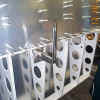There is a drain for the top port that exits on the bottom of the wing skin. Because of this, the bottom port is not directly under the top port. In this installation, it is mounted approximately 2" to the inboard side of the top port so the drain hole does not interfere with the bottom port. The tubing shown will be connected to the AOA computer in the cockpit along with two other tubes that are "T'd" into the pitot/static lines.
The drain port is used like a fuel drain (in fact it's the same as the one Vans ships) and needs to be checked before each flight. Here you can see the bottom pressure port and the drain. I will trim the drain (black) so that it is flush to the skin and the screws that hold the pressure ports in place will be dimpled and sealed with Proseal or Permetex Gasket Sealer.



